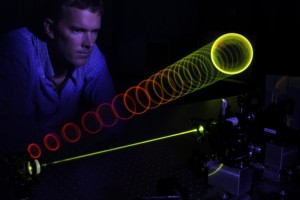
Colored rings of light are generated with a femtosecond supercontinuum source and an axicon, then captured with a long exposure digital image. In this photo, a supercontinuum source (lower right) emits a bright beam which traverses to the left. It passes through an axicon (lower left), which generates the circular beam pattern. The beam then reflects off a mirror and expands as it passes to the upper right. This photo was NOT photoshopped. It was achieved with a 30 second exposure. The solid beam was traced with a white card, the rings were generated by intercepting the beam with the card at regularly spaced intervals. During this exposure of the rings, the output of the supercontinuum source was adjusted from red to green. Finally, the equipment and Dr. Anderson were illuminated with a flashlight for the last few seconds of the exposure. Dr. Matt Anderson built the first femtosecond laser system at SDSU, and over the last several years has used this system to study the limits on pulse shaping and measurement, nonlinear effects in matter, and generation of novel femtosecond beams using spatial light modulators. These areas of research have been at the forefront of optical science for the last decade.

